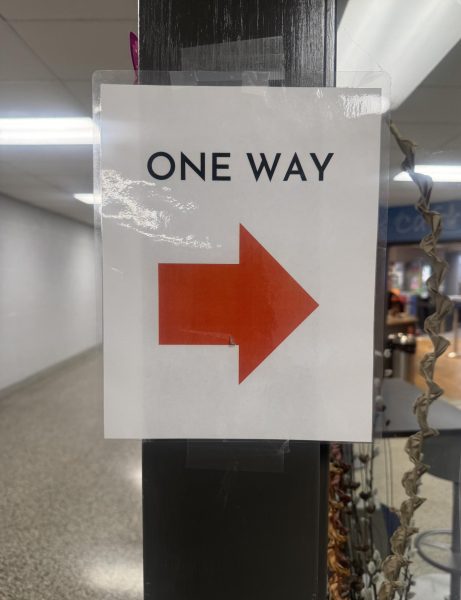Why?
That’s a question many ask while standing on the corner at one of the one-way hallways at Dallastown Area High School
One-way hallways have been a topic of conversation since first started in the 2020-2021 school year for social distancing after COVID-19.
But why are they still here?
According to DHS Principal Dr. Misty Wilson, the implementation of one-way hallways was intended to improve traffic flow and minimize congestion.
In the 2021-2022 school year, DHS tried to eliminate the one way hallways. It didn’t work. Administration felt they had two options: bring back the one way hallways or extend the time for passing between classes. They decided to stay with the hallways to preserve class time.
“If we could continue to preserve educational time, it seems like that is the best answer,” Wilson said.
However, the decision to keep them after the pandemic sparked controversy and mixed emotions among students.While Wilson stands behind the reasoning to keep the one-way hallways, not all students feel the same way.

“I hate the one-way hallways. I find it so stupid that I have to walk around the whole school even if my class is three doors down. It wastes time, and it’s still causes traffic. I literally still show up to class late,” sophomore Jannel Cordero Diaz said.
Junior Tatum Berry has a similar opinion.
“I feel like they are more time consuming because there isn’t always a direct path to your classes. It seems like i could get there faster if I could just go straight!”
Both sides have their points.
Some students feel that they get to class on time easier due to the system, but still get frustrated by the slow pace.
“For me, I feel like the one way hallways are beneficial when it comes to getting through busy hallways, but I don’t like that fact that some people would walk very slow and would bump and put their hands on others because they can’t get to where they’re going fast enough,” sophomore Hunter Smith said.
Some areas are trickier than others and sometimes those not following the rules create more issues.
“The area where the 400-hallway and the cafe meet up traffic seems to just stop. If people would follow the one-way hallway, it probably would move a lot faster,” junior Sophia Long said.
There are students who face more serious problems such as limited time and limited physical activity. As more students form opinions, it is clear that the system has impacted many students in a variety of ways.
And it’s not just at Dallastown. In several online student newspapers across the country, students are writing similar articles questioning the need of one-way hallways in their schools.
“Introduced during the 2020-2021 school year while students participated in hybrid learning, one-way hallways have been a hassle this year for students who attempt to navigate the hallways quickly. The intention behind them was to alleviate traffic jams in highly concentrated areas, as well as limit the potential spread of COVID-19 and close contact between students But with nearly two thousand students in the building this year, the hallways are more packed than ever, and because the new system forces students to follow a specific direction in each hall, they find it can be quite difficult to get to class on time since direct routes are sometimes not an option,” wrote Kyle Reeder of Midlothian High School in Virginia in the article “The Debate Over One-Way Hallways.”
While some schools have reverted back to traditional hallways, Dallastown kept one-way hallways to manage the busy traffic flow of the designated hallways.
As much as it’s a very popular topic for students to discuss, how does the staff really feel?
Wilson says it’s not the traffic pattern that dislikes but the enforcement of them.
“I am big on structure and routine, and the rules can make hallway travel efficient. The part I don’t like the most is when students stand at the cafe corner. I wish students would just follow the one-way halls and not cause congestion waiting at the café,” Wilson said.
In the future, could we see an end to one-way hallways?
As Dallastown continues change, there is always the possibility of changing, but Wilson says it probably won’t be anytime soon.
“I am a very reflective and solution-oriented person. Without any other viable alternatives at this time, they will most likely stay,” Wilson said.
But that doesn’t necessarily mean forever. Wilson describes “bubbles” of grade sizes that vary from year to year. As of right now the high school enrollment is the largest it’s ever been.
“If in the future, if class sizes were to all go down and there weren’t as many students to congest the hallways, it could be reevaluated,” she said.
So where does this leave Dallastown on the issue of hallway traffic.
According to administration, one-way hallways play an essential role in maintaining the safety, order, and efficiency in school as was as any busy environment, but students still aren’t sold.
Until we fewer students walking the halls of DHS, they just might be necessary.